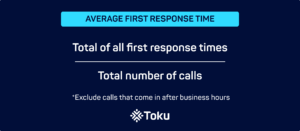Mae Emuslan has been at Toku for four years when she first started off as our NOC Engineer, and evolved into her present role as a Voice Engineer. As Toku turns four, she reflects on how the company’s diversity has helped her team achieve new highs.
Ever wondered how long it takes for a customer service agent to get back to a customer’s query? That’s what we call Average First Response Time. In simpler terms, it’s the time gap between when a customer asks something and when they hear back for the first time.
The formula is simple:

Why contact centre managers should care about Average First Response Time
This call centre metric is one of the most important ones for a reason:
People hate to wait.
A fast reply can make or break a sale and keep customers loyal. In other words, quick answers could mean more money in the bank and fewer people walking away.
Fast answers also keep customers satisfied, knowing their query is being handled by someone – which sets the stage for a good interaction. That’s where your team can really shine, making customers feel valued.
First response times also let contact centre managers know if their staffing plan is working or needs a tune-up. It’s a great way to learn from the past and plan better for the future.
If your first response time starts to slip, watch out because customers might start flooding your other contact methods – like your social media – to get the answers they want.
Ouch!
Real-world use case
Let’s say you’re running a call centre for a bank.
You might have a service level that says: Respond to 80% of calls in 20 seconds.
This 20-second goal is the target average first response time, and it will be used by the administrator to track the agents’ performance.
By keeping an eye on first response times, you might start to notice trends like credit card promotion queries having longer response times. That could be a signal for you to allocate more staff towards answering these calls.
How to improve average first response times
- Monitor in Real-Time: Use a Contact Centre as a Service (CCaaS) platform that shows you response times as they happen. This lets you jump in and fix things before they get worse.
- Quick Replies for Repetitive, Easy Questions: Some questions are super simple. Use automation and self-service solutions to lower call volumes, which will allow your agents to pick up calls with less delay.
- Train Your Team: Make sure everyone knows why quick replies matter and how to make them happen. When agents understand the importance of responding quickly, they will be more motivated to pick up calls faster and escalate inquiries effectively.
- Smart Routing: Use a system that knows which questions are urgent and sends them to the right agents who are not as occupied and will be able to respond faster.
- Do Not Include Automated Virtual Assistant Responses: When calculating first response times to report on agent performance to management, it might be tempting for a supervisor to include automated responses to make the numbers appear better than what they are. However, because automated replies are ‘immediate,’ they should not be counted.
- Do Not Include Queries Received After Business Hours: First response times that exclude after-hours calls offer a more accurate picture of your team’s performance. Also, it sets realistic expectations, and makes for better decision-making.
First response time can make or break your customer experience
By staying on top of it, you’re not just hitting your targets; you will be creating an environment where customers feel heard and valued.
If you gain a reputation for responding immediately, that credibility can become a unique selling point for your business.
This can positively impact retention and attract new business.
 V K Sanjeed
V K Sanjeed 


 Mae Emuslan
Mae Emuslan 
